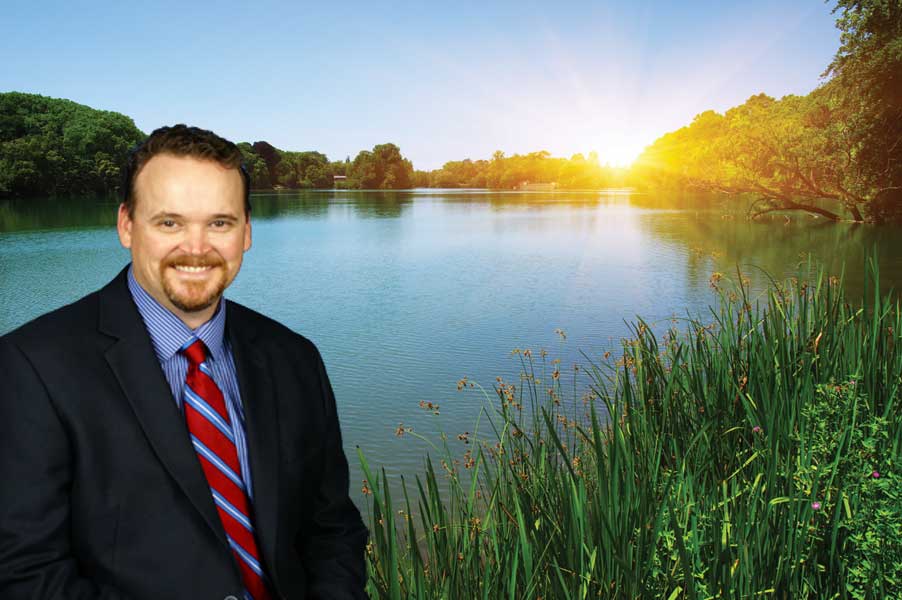by CHERYL ROGERS
Brian Armstrong, the executive director of the Southwest Florida Water Management District, is bringing together people and organizations to prepare for a growing demand for water.
Since the Southwest Florida Water Management District was created to mitigate flood control in the wake of Hurricane Donna in 1960, its role has expanded to include responsibility for the region’s water supply, water quality, and natural resources. The man charged with overseeing that task is Brian Armstrong, a 20+ year veteran of the industry, who spent a lot of time as a youth fishing on Hillsborough County’s Egypt Lake.
A native of Melbourne, Armstrong grew up in the Tampa Bay area, where he witnessed the devastation – and restoration – of Tampa Bay over a 30-year span. “It was cheaper to buy property on the bay than off the bay,” he recalls.
The district helped fund many projects that were able to restore sea grasses to levels from the 1950s, making the bay a “top fishing destination” once again, he says.
Armstrong holds a bachelor’s degree in Geology and master’s degree in Hydrogeology, both from the University of South Florida. A licensed professional geologist, he lives in Pasco County’s San Antonio community with his wife Pamela and two sons.
His career began as a district field technician working with water use permits in the Bartow office, but today home base is primarily in Brooksville. As SWFWMD’s executive director, he manages some of the state’s largest water resource initiatives in a region encompassing all or part of 16 counties including Polk, Highlands, Hardee, Hillsborough, Manatee, Pasco, Pinellas, Sarasota, Citrus, DeSoto, Hernando, Sumter, Charlotte, Lake, Levy, and Marion.
He has developed a reputation for coordinating – and collaborating with – water-related initiatives involving a variety of governmental agencies. A prime example is his role as the district’s negotiator in founding the Polk County Regional Water Cooperative, which brought together the county and 15 municipalities with a common mission.
The district currently is working to ensure there is an adequate water supply in an area he describes as “the bedroom community for Disney.” It appears meeting demand will require drilling deeper, into the brackish lower Floridan aquifer, and treating the water more vigorously.
The district’s Regional Water Supply Plan in 2015 projected water needs would rise by 22 percent in Polk County by 2035. In a four-year period, it’s set aside $40 million for the task.
“Right now we’re spending about $11 million of that in a feasibility study looking at three sources,” he says, adding the other half is being paid by the cooperative.
The plan itself may cost $300 million to implement, with the district sharing expenses with regional authorities. Construction at one or two sites could potentially start between 2020-2025, Armstrong says.
A report is due in two years. Efforts center on three potential sites at Crooked Lake, Frostproof, and Lake Wales, according to the district’s website.
They hope to be able to meet demand for 50 years. “The whole premise of it is to identify a source,” he says.
On the job, Armstrong is innovative in his approach. The district has a couple of feasibility studies underway that eventually could lead to placing treated, reclaimed water into the ground in areas that don’t supply groundwater. The goal is to eventually boost groundwater supplies.
The studies should be completed in two years.
In Clearwater, highly treated wastewater already is being put into the ground where it will eventually filter into the community’s drinking water and be treated before use.
Armstrong’s career got a boost when he became involved in an endeavor to help trees at Flatford Swamp in Manatee County. “The trees were drowning in the swamp.
That happened as a result of runoff primarily from agriculture and development in the area,” he says.
He started two agriculture initiatives that used swamp water for irrigation. As a result of these successful partnerships, the program Facilitating Agricultural Resource Management Systems, or FARMS, was born. That has grown into “a huge program for the district” involving hundreds of farms, he says.
Among his other accomplishments are establishing the district’s first business plan and Project DIVE – an acronym for Define Investigate Verify Enact, the district’s first continuous grassroots-based improvement program relying on staff suggestions. “They’re closer to the work. They’re going to know where we can make the improvements,” he says.
He formed DIVE while serving as assistant executive director overseeing day-to-day operations for three divisions.
In the future, SWFWMD officials hope to improve water quality in five springs in the district, including Weeki Wachee, Chassahowitzka, Crystal River/Kings Bay, Rainbow, and Homosassa. Nutrients such as nitrogen and phosphorus are entering the spring waters, promoting algae blooms. While this doesn’t impose a health threat, it does affect wildlife and recreational use of the springs.
The blooms are invasive and take over the spring’s plant community. “It impacts the beauty of the spring, the aesthetics of the spring,” he explains.
The state has allocated $50 million annually for the springs, which flow from the aquifer. A plan to replace septic tanks with centralized sewage, to improve water quality, is still up for approval by the state’s Department of Environmental Protection, where Armstrong worked as assistant director of the Southwest District between 2012-14.
Costs may potentially be shared by the entities involved. A DEP decision is anticipated by September.


